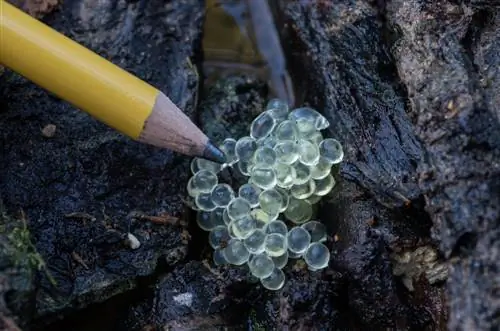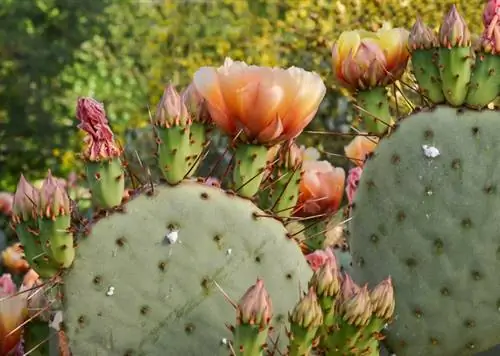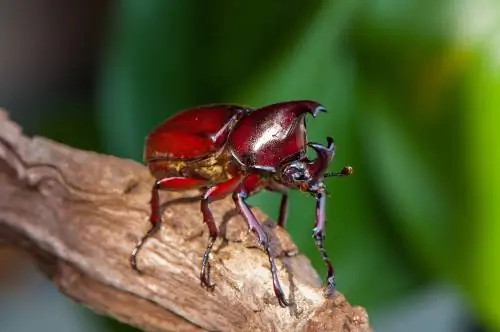- Author admin [email protected].
- Public 2023-12-16 16:46.
- Last modified 2025-06-01 06:02.
It is not pleasant for any gardener to find snail eggs. It is usually not clear whether it is a beneficial or harmful species. Snail eggs are often confused with earthworm egg capsules or slow-release fertilizer. Color and consistency as well as the storage location provide information.
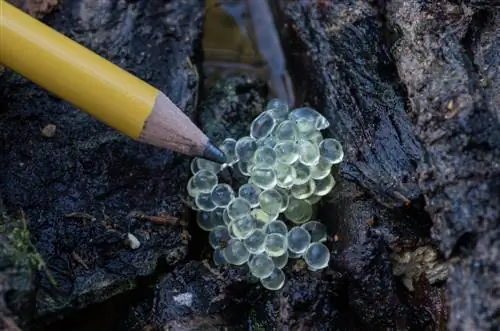
What do snail eggs look like and how can you get rid of them?
Snail eggs are usually spherical, whitish, translucent and soft. They are found in moist, warm environments such as compost, burrows or under densely growing plants. To dispose of them, they should be dried or overheated, for example by exposure to sunlight or in the composting process.
What do snail eggs look like?
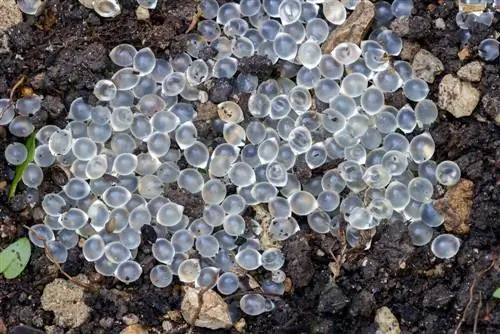
Snail eggs are spherical
Snail eggs are whitish, translucent and spherical. Their water-light color makes them stand out from the earth. They can reach the size of a pinhead and lie loosely together in small clusters. By squeezing, you will notice that snail eggs are very soft and give way easily. If you are unsure, consult pictures of snail eggs.
| Number of eggs in the clutch | Coloring | Storage location | needed | |
|---|---|---|---|---|
| Snail | 40 to 60 | whitish, only slightly translucent | self-dug earth pits | 3-5 cm loose soil |
| Spanish slug | up to 225 | shiny whitish, not transparent | Earth surface, plant litter, burrows | humid and shady environment |
| Tiger Snail | 100 to 300 | transparent, clear and colorless | Substrate surface | warm and humid environment |
| Grove Snail | 30 to 60 | whitish with lime peel | self-dug earth caves | moist tall shrub meadows |
Typical storage locations
If you find what appear to be snail eggs, pay attention to the surrounding conditions. The location where it was found gives you clues as to whether it is a clutch of snails. Snails prefer well-protected and moist areas to lay their eggs. They prefer to place their clutches in compost, under densely growing plants or in burrows and dead wood.
This is where you should look for snail eggs:
- under plant pots, buckets and troughs
- in dug up beds and piles of leaves
- under moss blankets and bark mulch
- between paving slabs
- under loose stones

When do snails lay their eggs?
The Spanish slug begins to lay its eggs in suitable places from the end of June. There is a peak between August and September. In particularly mild years, egg laying continues into December. It is therefore important that you remove clutches of this species before winter. The eggs overwinter and cause a plague of snails the next spring.
Excursus
This is what depot beads look like from the inside
Nutritional s alts are coated with a layer of synthetic resin. This shell has fine and microscopic pores. The beads absorb water in the soil so that the powdered nutrient s alts are dissolved inside. The dissolved s alts are sucked out of the grain with the water. This process occurs slowly, so that the plants are supplied with nutrients for up to six months. However, there are depot beads that last for different durations and are colored yellow, green or red depending on their duration of action.
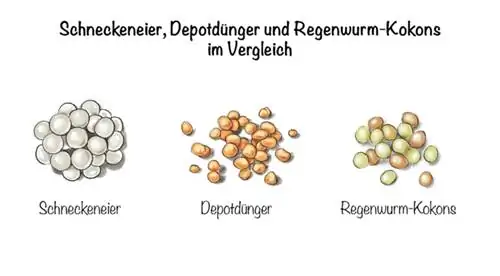
How can I get rid of snail eggs?
Robin snails eat snail eggs and therefore prove to be useful helpers in combating slugs. Tiger snails are also beneficial insects and should be protected. The easiest way to kill eggs from unwanted snails is to dry them out. Place the clutch in a sunny location. Hedgehogs and birds clean up the leftover residue.
Factors endangering snail eggs:
- high temperatures
- low humidity
- direct UV radiation
Snail eggs in the aquarium
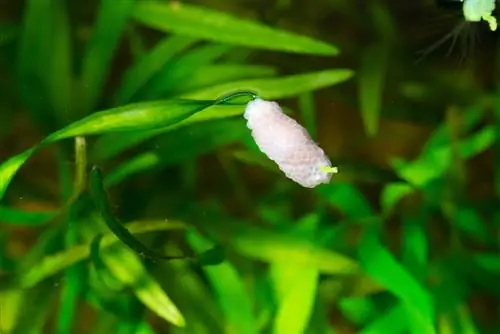
If snail eggs are unintentionally introduced, they should be removed as quickly as possible
Eggs are often introduced into the system through aquatic plants. As soon as the young animals hatch, they spread en masse. Such spontaneous accompanying fauna can have a positive effect on the habitat because water snails accelerate the decomposition of organic remains.
How to recognize snail spawn:
- often small white cocoons
- sometimes colorless and transparent or yellowish eggs
- gelatinous structures in which a point can be seen
- stick to windows, decoration, aquatic plants or technology
Many clutches are difficult to remove, so you should remove the adult snails from the aquarium. They can be attracted with a lettuce leaf or a piece of cucumber. As soon as the animals have settled on the treat, you can remove it from the water. To avoid introduction, wash newly purchased aquatic plants thoroughly before planting.
Combat control
You can collect visible clutches on the compost and let them dry out in the sun. If you notice that snail eggs have been laid in deeper layers, you should mix the compost thoroughly and regularly. Make sure there is good ventilation and prevent the substrate from becoming too wet. In a functioning compost, temperatures of more than 60 degrees arise during hot rotting. This kills snail eggs.
Tip
If snail eggs have survived despite the high temperatures, store the substrate in the sun or spread out on the unplanted bed before spreading. Here the remaining eggs dry out quickly.
Snail eggs in potting soil
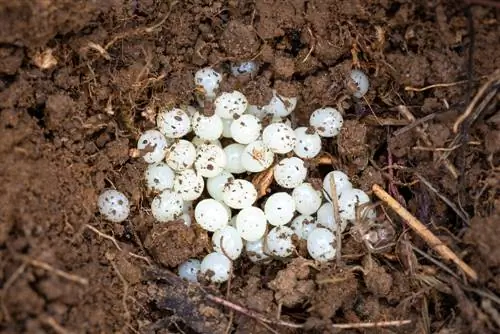
If snail eggs are discovered in the flower pot, the plant should be repotted as quickly as possible
It can happen that snails lay their eggs in the potting soil or on the surface of the substrate. This is the case if you place potted plants on the terrace and balcony in summer. Since the plants are watered frequently, a warm, humid microclimate develops in the pot ball. Wild plant growth, such as that found in some balcony boxes, favors the survival conditions for snail eggs.
How to destroy snail eggs:
- Get the pot ball out of the planter
- shake off old substrate
- examine for clutches
- Dry the soil over a wide area in the sun
- then composting
Tip
If you're not sure, crush what you think is the egg between your fingers. Depot fertilizer balls crack when the synthetic resin casing breaks. Snail eggs are slippery to the touch and can be crushed noiselessly.
Preventing snails in the garden
Since chemical agents are unsuitable for combating snails, prevention is of great importance. If snails have already established themselves, check the snail hotspots regularly. You can take appropriate measures to bring the volume under control.
Digging up beds
Dig up your beds in late fall after the main egg laying period. It is beneficial to level the crumbly soil evenly. This means that snails cannot find hollows in the ground and are prevented from laying eggs. The measure should be repeated in early spring so that previously undetected egg clutches can be revealed and removed.
Snails hibernate when they are young or in the egg stage. Therefore, the eggs laid in autumn are a spring danger.
Avoid mulching
If you have been struggling with a snail infestation for a long time, you should avoid a layer of mulch. This protects the soil from drying out and ensures a warm, moist environment in which snails also feel comfortable. If you still have to mulch in spring, you should remove the layer from the beds by August at the latest.
Frequently asked questions
How long does it take for snail eggs to hatch?
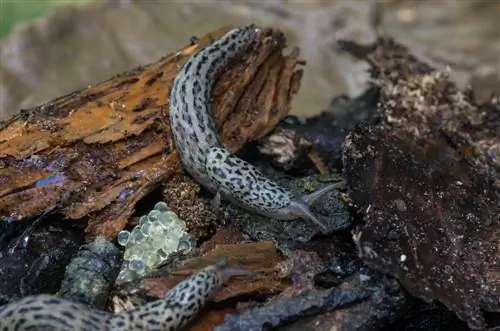
How long the snails need to hatch depends on the type of snail and the outside temperature
When exactly young snails hatch depends on the type and time of egg laying. The Spanish slug lays eggs several times a year. Clutches produced in June develop into snails in the same year. Eggs laid later survive the winter, so that the young snails hatch between February and March of the following year.
The temperature also has an influence on the speed of development. At 20 degrees, the first snails hatch just 30 to 37 days after laying their eggs. Temperatures between ten and 15 degrees are ideal. If the thermometer rises above 25 degrees, development stops and the eggs die.
Can I specifically hatch snail eggs?
If you know that it is a useful species, you can collect the clutches and place them on moist soil in a screw-top jar. Place the glass in a shady, mild place and ensure high humidity. But be careful, because Roman snails are protected. Snails and their clutches must not be collected from the wild.
I bought a pack of potting soil and when I opened it I noticed little yellow balls. Are these yellow snail eggs?
You don't have to worry about buying contaminated potting soil. Snail eggs are not yellow, but whitish and translucent. When you take the yellow colored balls in your hand, you will feel a firm consistency. Snail eggs would not be easy to touch because they are very soft and sensitive to pressure. They feel wet and slippery. By the way, the fertilizer balls can also be colored green. This colored coating gives gardeners information about the duration of the fertilizer effect.
Detecting fertilizer balls:
- loosely distributed in the substrate
- cracking when crushed
- empty shell does not dissolve
- Contents of fresh balls are dry and powdery
I don't think there are any little yellow fertilizer balls scattered around my garden. Are there any other eggs that could be considered?
If the eggs are lemon yellow or brownish in color and more or less clearly pointed at both ends, they may be an earthworm egg capsule. This earthworm cocoon contains a nutrient fluid so that the offspring are well supplied. Earthworms lay their eggs in the upper layers of the soil and often cover them with a protective covering of feces. Depending on the species, the size and color of the cocoons can vary. They are around two to seven millimeters long and are initially not translucent but shiny. As they develop, the cocoons become transparent.

